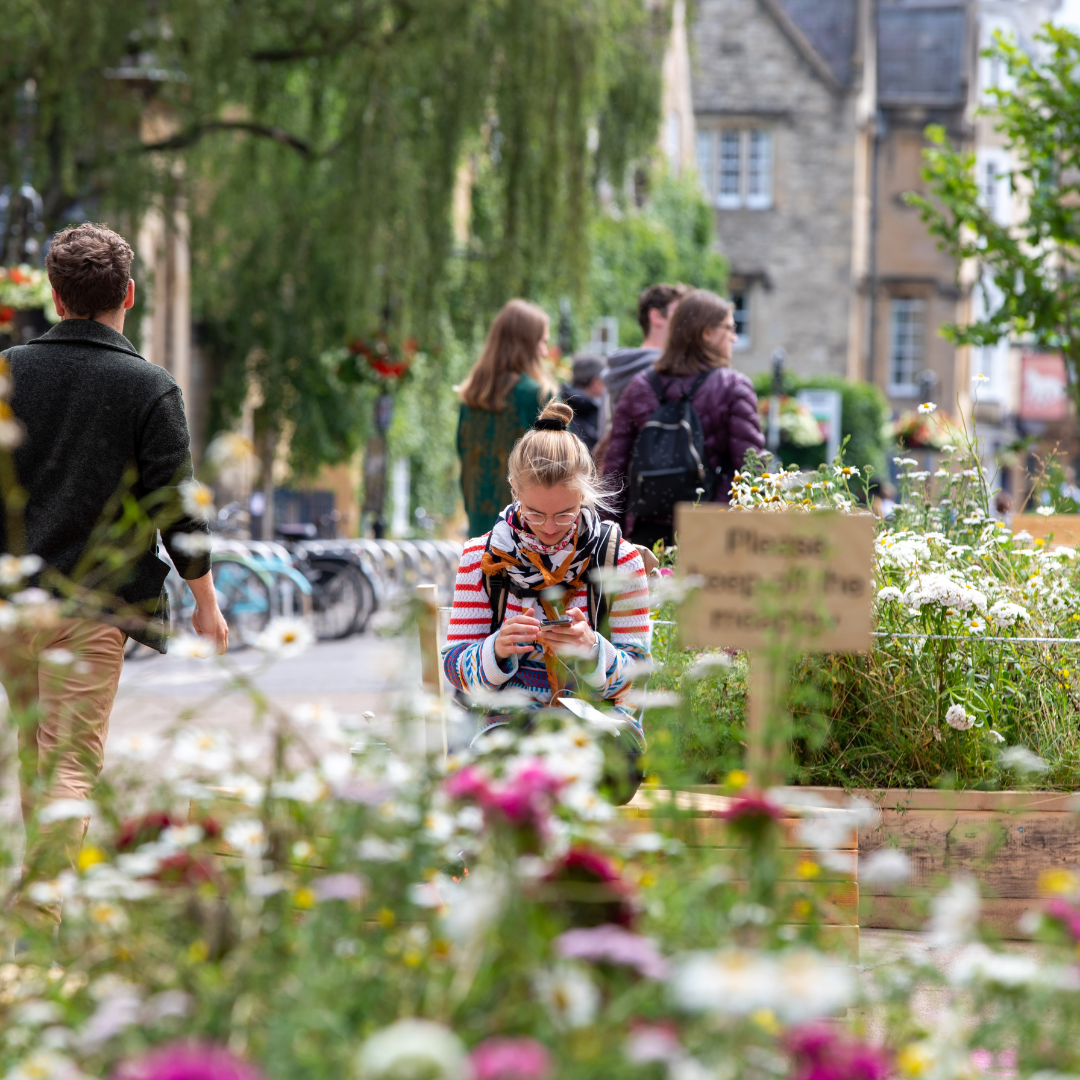Project showcase
Broad Meadow, Oxford – Oxford City Council with LDA Design

This scheme was created to aid post-pandemic recovery and to provide long-term guidance on how to create healthier, higher-quality, car-free public spaces across Oxford.
Where is the project located?
Broad Street, Oxford OX13BD
Who is the developer/client of the project?
Oxford City Council
Describe the context of this project and its neighbourhood and people?
Broad Street is a national gem and an obvious place to start exploring Oxford. The street is steeped in history dating back to AD911 and is central to the city’s life. It is home to Balliol and Trinity colleges, Bodleian Library, the Sheldonian Theatre and Museum of the History of Science, the original Blackwell’s bookstore and now eclectic range of independent shops. In the middle, a cross marks where three martyrs were burnt at the stake in 1555 and 1556. Three Grade 1 listed buildings run its entire length, and there are 24 Grade II listed shops and college buildings. Its proportions are so wide and generous, it once served as the city’s horse market.
A city street with this much heritage should be celebrated, but today Broad Street’s poor-quality public realm lets down its historic splendour. Broad Street is dominated by an over-sized highway with narrow pavements, on-street parking and street clutter, including A-boards and utility boxes. It is a place to move through quickly. There are few opportunities to socialise, sit and pause, or eat outdoors. It has no dedicated space to host community events or for the colleges and institutions to comfortably spill out.
Oxford City Council (OCC) wanted LDA Design to test part-pedestrianising the street to create a large civic space. Plans were informed through discussion with local stakeholders, businesses and advocacy groups. The scheme was designed to support post-pandemic recovery, and to inform long-term options for creating healthier, better quality, car-free public spaces across Oxford.
Tell us what you did and how the project, event or installation enlivened the place in a creative way?
Changing historic street design is challenging. LDA Design’s brief was to demonstrate Broad Street’s greater civic potential, and to reclaim it for residents, businesses, shoppers, workers, students and visitors. Working with the Council, we turned car-clogged Broad Street into wonderful Broad Meadow.
By closing the western half of the street to cars, we created one of central Oxford’s largest civic spaces, a pedestrian-friendly, sociable and green destination with wildflowers, trees and small lawns, and moveable seating. A two-way cycle route running the street’s length remained. Final designs were informed by discussions with cycling and disability groups through the Inclusive Transport and Movement Forum.
The space was transformed with wooden seating and planters made from recyclable materials by local makers, including pallets used to transport vaccines and PPE during the pandemic. Muralist Bryony Benge-Abbott drew a colourful, nature-inspired floorscape to add detail, definition and delight.
Broad Meadow was an opportunity to bring people back to the city, supported by a successful and diverse summer programme of community events. The ambition was to create a flexible space to showcase Broad Street’s potential and to build momentum towards the delivery of a permanent scheme. Changes, although temporary, were well integrated within the historic context.
The project involved an intense period of design including a TTRO application and engagement with over 40 different organisations. The scheme was designed and delivered within 12 weeks.
Public response was captured to inform more lasting council decisions and the wider transformation of Oxford’s streets and spaces.
Please share any data or figures that support your entry, for example increased footfall, happiness surveys, event attendance and/or observed changes in behaviour.
From July to October 2021, over 100,000 people used Broad Meadow. It was designed to make people smile, as a place that everyone could enjoy, and as an inclusive space to encourage discussion on Oxford’s public realm with the whole of the city.
More than 1,000 online survey responses were collected, with 87% of respondents considering Broad Meadow a positive move. Nearly half said they used the space to meet people and that it had made them feel much more positive about visiting the centre post pandemic. Eighty per cent backed making it permanent, strong affirmation particularly for a historic street where changes – even minor ones – can be controversial.
The temporary space was able to adapt well to different needs. Weekend community events included Youth Takeover Day, the Feel-Good Fair and Go Active Families. Oxford marked World Car-Free Day here and the Story Museum celebrated Alice Day, an annual city-wide festival honouring Alice in Wonderland, with a performance – happily on National Meadows Day! From the get-go, people used the seats and lawns to chat with friends, read or take a moment.
The space proved so popular, the summer scheme was extended into October to accommodate the city’s annual Arts Market. It also meant returning students could give feedback.
In an unprecedented move, the Oxford Preservation Trust awarded a plaque to a temporary project for “its huge impact on the public realm over the summer … bringing liveliness and hope for the future of Broad Street.”
Did the project make a positive social and environmental contribution? Please provide any evidence or data to support this.
Broad Meadow was designed to reboot Oxford’s post-pandemic economy and show how the street could become a greener, safer, car-free space in the heart of the city.
The evidence for a positive social contribution is clear in Oxford’s residents’ overwhelming support for the reimagining, with 80% of survey respondents backing permanent pedestrianisation of the whole of Broad Street, not just the western end. Broad Meadow gave people a glimpse of the future, and the chance to comment on and shape plans for the city’s public realm so that it better meets local needs and the city’s environmental ambitions.
Sustainability was one of the scheme’s core objectives. This was understandably challenging for a temporary scheme, with the longevity of assets of particular concern. Making use of recycled materials such as wooden pallets for the seating was valuable but would have been insufficient on its own to ensure a long-term, positive social and environmental contribution.
Before the scheme concluded, OCC made a public call for expressions of interest from community groups and charities to find more permanent homes for the infrastructure elements. So, when the scheme finished, the planters and seating, turf and plants were re-used by an adventure playground, Cowley Children’s allotment, Marston Community Garden, Oxford Urban wildlife group, St Ebbe Primary School and St Mary Magdalen Church.
One Twitter user called Broad Meadow, “The People’s Quad”, which we think sums up its contribution well. Another wrote, “I didn’t think Oxford could get any better … but woweeee, she just did.”
Festival of Pineapples
24-26 February 2026
Pineapples prize giving night
April
Pineapples at Festival of Place
10 June 2026
© The Pineapples - Tweak Ltd. 124 City Road, London, EC1V 2NX. Tel: 020 3326 7238




